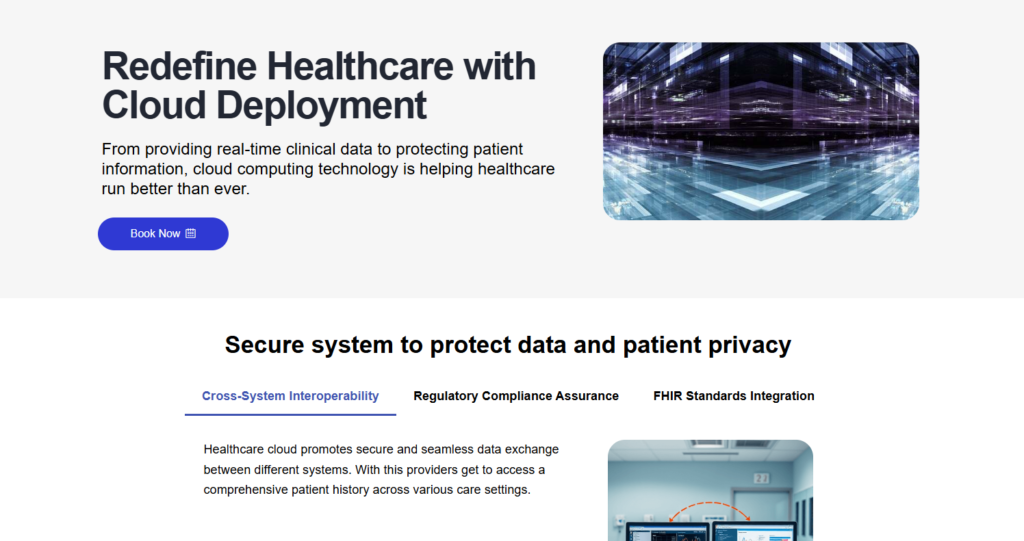Cloud Adoption in Healthcare is slower beause healthcare organizations handle highly sensitive data, so it’s no surprise they’ve been more cautious about moving to the cloud than other industries. Our latest report, “Skyhigh Security Cloud Adoption and Risk Report: Healthcare Edition,” highlights this hesitation, even as the sector faces increasing pressure to modernize.
In the past, most healthcare data was kept in on-premises data centers due to strict compliance rules and the need for quick access to patient records. Key findings from our report explain why cloud adoption in healthcare has been slower.
Currently, only 47% of sensitive healthcare data is stored in the cloud, compared to 61% across other industries.
Table of Contents
What is Healthcare cloud adoption?
Healthcare cloud adoption means shifting healthcare services from on-site systems to the cloud. This lets providers store, manage, and process patient data and applications remotely. The transition happens gradually to avoid downtime. A cloud adoption plan helps organizations move from traditional IT to modern, flexible solutions.

Healthcare IT Leaders Struggle with Cloud Adoption Despite Push for AI
A Presidio survey found that despite efforts to adopt cloud computing and artificial intelligence (AI), healthcare IT leaders still face cloud adoption challenges.
Turnover Slows Cloud Adoption
The pandemic accelerated digital transformation, forcing healthcare IT leaders to fast-track cloud adoption. However, 52% cited compliance as the main driver, followed by 46% wanting greater agility and innovation.
Sam Fatigato, VP of Presidio’s Cloud Solutions Group, highlighted a skills gap in AI and automation. Only 21% of healthcare IT leaders feel proficient in AI/ML, and just 23% say their team is skilled in DevOps and automation.
A key factor behind this gap is high staff turnover, reported by 35% of IT leaders. Fatigato suggests that partnering with a technology provider can help bridge skill gaps, allowing in-house IT teams to focus on critical tasks like security and system maintenance.
Why is Healthcare Lagging in Cloud Adoption?
Many healthcare organizations struggle with outdated, siloed IT systems, making it difficult to integrate cloud solutions. On-premises setups are slow, rigid, and less adaptable compared to cloud platforms.Cloud adoption is also essential for meeting evolving compliance standards like ISO 27001 and SAS 70, along with cybersecurity frameworks from agencies like CISA and NIST. Fatigato advises healthcare organizations to ensure their systems align with new privacy regulations.
1. Competing Priorities and Budget Constraints
Despite advancements in cloud technology, healthcare organizations struggle to prioritize cloud adoption. Budget limitations, staffing shortages, and the impact of the pandemic have forced hospitals and health systems to focus on immediate operational needs rather than long-term digital transformation. As a result, adopting new technology, such as cloud-based systems, often takes a backseat to pressing concerns like patient care, workforce management, and regulatory compliance. Without dedicated resources, healthcare providers find it challenging to shift their IT infrastructure to the cloud.
2. Uncertainty About Cloud Migration Benefits
Healthcare decision-makers often weigh the cost of cloud adoption against its perceived benefits. While cloud solutions promise improved security, stability, and compliance, many organizations focus primarily on short-term cost savings, potentially overlooking the long-term value. Concerns over performance reliability, data privacy, and regulatory adherence further slow decision-making. Without a clear understanding of the full advantages, healthcare IT leaders may hesitate to replace familiar on-premises systems with cloud-based solutions, delaying adoption and innovation in digital healthcare services.

3. Legacy Systems and Risk of Data Migration
Many healthcare providers rely on outdated on-premises IT systems, making cloud adoption in healthcare complex. A lack of risk analysis for transitioning these legacy systems creates uncertainty regarding data integrity, compatibility, and security. Issues like software patching, firmware updates, and integration with existing dependent systems can complicate cloud adoption. The fear of potential disruptions or data loss during migration discourages healthcare organizations from transitioning, leading many to continue operating on legacy infrastructure despite the benefits of cloud technology.
4. Compliance Risks and Licensing Concerns
Healthcare organizations operate under strict regulatory frameworks, and cloud migration introduces concerns about maintaining compliance. Failure to configure cloud environments according to recommended security and privacy settings may result in non-compliance with industry standards such as HIPAA. Additionally, large healthcare entities that have invested in on-premises infrastructure may lose existing discounts on software licenses and hardware, making them reluctant to transition. The uncertainty around compliance risks and financial implications can further deter healthcare organizations from fully embracing cloud adoption.
Healthcare Needs a Clearer, More Trustworthy Cloud Approach
Many healthcare organizations lack a clear, high-level view of their cloud environment, largely due to outdated, disconnected tools that don’t integrate well. 89% of healthcare organizations say managing cloud security should be simpler, compared to 86% in other industries.
Because of HIPAA compliance, healthcare is less likely to store sensitive patient data in the cloud but more likely to store internal data and use cloud-based collaboration tools for remote work.
Since 2019, trust in the cloud for HIPAA-protected data has declined, even as overall cloud adoption in healthcare has increased.
How to pace up Cloud Adoption in Healthcare?
Healthcare organizations are turning to AI and cloud solutions to improve patient engagement and administrative efficiency. Northwell Health, in partnership with Google Cloud, is using AI to automate workflows and identify patient risk factors for early intervention.
During the pandemic, healthcare providers with cloud-based systems were able to adapt quickly and maintain patient services with minimal disruption.Fatigato concluded that cloud adoption not only drives innovation but also strengthens cybersecurity in an industry facing a surge in cyberattacks over the past two years.
1. Enhance digital literacy among Healthcare staff
Healthcare organizations must invest in comprehensive training programs for clinical and administrative staff. Digital literacy is foundational to cloud adoption success. Implement role-specific training modules focusing on relevant cloud tools, data management, and security protocols. Create a core team of “digital champions” across departments who can provide peer support and troubleshooting assistance. This improves confidence, reduces resistance to change, and enables staff to leverage cloud capabilities effectively. Regular training sessions ensure continuous skill development as technologies evolve.
2. Implement strategic data migration
Develop a phased approach to data migration rather than attempting a complete system overhaul. Begin with non-critical systems while maintaining parallel legacy operations temporarily. Prioritize standardizing data formats and cleaning records before migration to prevent compatibility issues. Utilize specialized healthcare data migration tools designed to handle protected health information securely. Implement rigorous validation protocols during and after migration to ensure data integrity and compliance with regulations like HIPAA. This methodical approach minimizes disruption to patient care.
3. Foster collaborative vendor partnerships
Select cloud service providers with demonstrated healthcare industry expertise and HIPAA compliance capabilities. Negotiate contracts that address healthcare-specific needs including guaranteed uptime for critical systems, comprehensive disaster recovery, and clear data ownership terms. Establish joint governance committees with vendor representatives to ensure ongoing alignment with evolving healthcare requirements. Work with vendors to develop implementation roadmaps that respect clinical workflows and patient care priorities. These partnerships should emphasize knowledge transfer to build internal capabilities over time.
4. Prioritize Interoperability Standards
Adopt cloud solutions that adhere to healthcare interoperability standards such as FHIR, HL7, and DICOM. Ensure new cloud systems can communicate seamlessly with existing electronic health record systems and medical devices. Participate in industry interoperability initiatives and health information exchanges to expand connectivity capabilities. Implement API-based architectures that facilitate secure data sharing across the healthcare ecosystem. Robust interoperability enables better care coordination, reduces duplicate testing, and improves the patient experience while maximizing the value of cloud investments.

Why is himcos your trusted partner for Cloud Adoption in Healthcare?
From providing real-time clinical data to protecting patient information, cloud computing technology is helping healthcare run better than ever. Move workloads to the cloud, transition toward a hybrid environment with Himcos as our niche focussed team knows the ins and outs of all the healthcare industry workflows and follows a vision to meet ongoing refinements and adapt plans to meet evolving needs.



